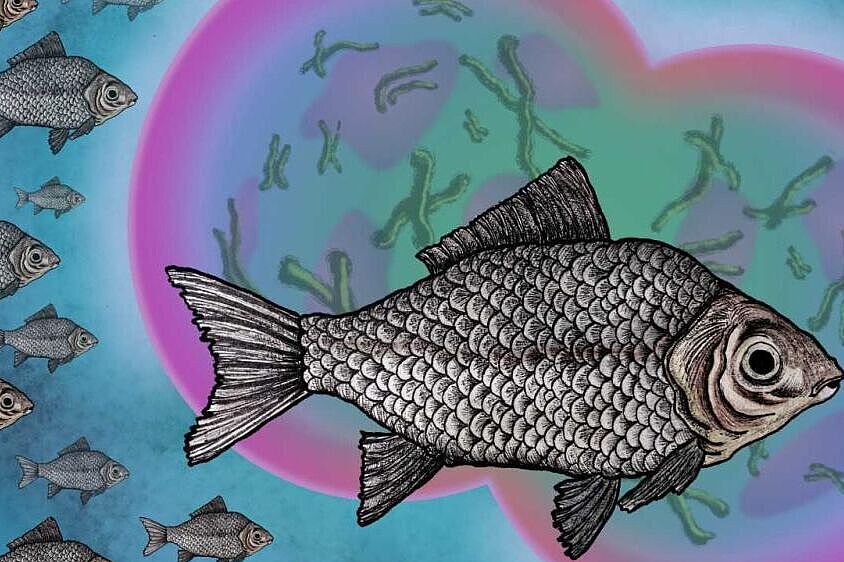Researchers decode the unusual genome of the Prussian carp

Now the entire genome of the Prussian carp, which reproduces via virgin production, has been decoded. | Illustration: Fabian Oswald
The Prussian carp or Gibel carp is considered one of the most successful invasive fish species in Europe. Its ability to reproduce asexually gives it a major advantage over competing fish. An international research team has for the first time described the complete genome of the Prussian carp. This also provides a much better understanding of its unusual reproductive method and to improve its management. The study, co-led by Dunja Lamatsch of the Research Department for Limnology, Mondsee, of the University of Innsbruck and Matthias Stöck of IGB, was published in the journal Nature Communications.
The Prussian carp (Carassius gibelio), native to Asia, is an invasive species in Europe. It is a close relative of the goldfish, and competes with the endangered native Crucian carp for the same habitat. However, while goldfish and Crucian carp usually reproduce sexually, the Prussian carp has a major evolutionary advantage: females can save the time-consuming search for a mate.
Sperm-dependent parthenogenesis in the water
Instead, female Prussian carps use sperm of male Crucian carps, or other carp species. To do this, they intermingle with a school of Crucian carp and allow their laid eggs to be fertilized by their males.
The hijacked sperm stimulate the egg cell of the Prussian carp to divide. Subsequently, the genetic material of the foreign male is degraded in the egg cell; this is called sperm-dependent parthenogenesis, or virgin production. All offspring produced in this way are female clones of the Prussian carp female. Most Prussian carps are therefore exclusively female; males occur only rarely.
"Unisexual, or purely female reproduction enables rapid colonization of new habitats and offers invasive species a major advantage over their original competitors," explained Dunja Lamatsch from the Research Department for Limnology, Mondsee, of the University of Innsbruck. Her research focuses on studying the mechanisms of unisexual reproduction in aquatic organisms.
"The high-resolution genome decoding also allows genetic sex determination to be studied in the future. This opens up new avenues for understanding and managing this ecologically problematic species," said evolutionary biologist, Privatdozent Dr. Matthias Stöck, from the Leibniz Institute of Freshwater Ecology and Inland Fisheries in Berlin (IGB).
In this study initiated by Lamatsch, she and an international team of researchers were able to completely decode the genome of the Prussian carp. As a result, the mechanism behind its unisexual reproduction can now be better understood.
Genome-amplification leads to new species
The total heritable information of an organism, the genome, is divided into different sets of chromosomes. Animals that reproduce sexually usually have a double (diploid) set of chromosomes. For reproduction, in females and males, the chromosomes are divided into germ cells (meiosis) and only one single (haploid) set of chromosomes is passed on at a time. The fusion of a haploid egg and a haploid sperm finally restores a diploid organism.
However, accidents during meiosis or crossbreeding of related species repeatedly result in organisms that have more than 2 sets of chromosomes (polyploid). Polyploid mammals and birds are hardly viable, but fish, amphibians and reptiles are. In this way, even new species can arise - like the Prussian carp.
Origin of unisexuality
The Prussian carp is hexaploidy - this means it has six sets of chromosomes. Four of them came together by crossing two only distantly related fish species - the other two were added by crossing with a closely related or even con-specific fish.
"Presumably, these combinations caused problems in the formation of the gametes. That could be one of the triggers of unisexual reproduction," Lamatsch explained. "In species that reproduce parthenogenetically meiosis fails, and fusion of gametes is no longer necessary."
In cooperation with research groups from IGB and the University of Würzburg, it was possible to dissect the genome of the Prussian carp into individual chromosome sets. This is the first time that the entire genetic information of a hexaploid animal has been described, and all six sets of chromosomes have been analyzed. The genome of the Prussian carp consists of a total of 150 chromosomes, more than three times as many as the human genome.
"The reconstruction of all chromosomes of a hexaploid vertebrate genome from sequencing data is a very complex bioinformatic problem, which we have now been able to solve for the first time by using the latest sequencing technologies. The freely available data created with the help of the EU project EASI-Genomics will in future serve as a reference for the further development of software for assembling polyploid genomes," said genomics expert Dr. Heiner Kuhl from IGB, first author of the study.
The analyses sheds light on how these six sets of chromosomes can coexist and work together. The resolution of all 150 chromosomes makes it possible for the first time to understand the entire genome structure of the Prussian carp as well as its complicated evolutionary history. Thanks to the high resolution of the genome, the researchers have already been able to discover many selective gene deletions that were overlooked with previous methods. This opens up many more interesting research questions around the invasive fish.






